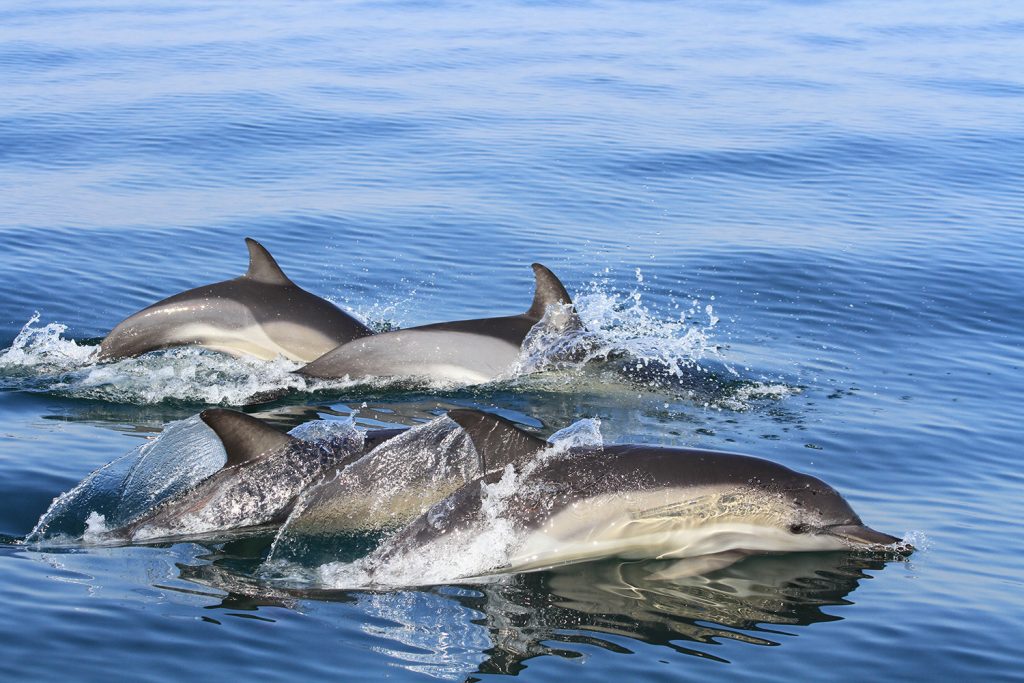24 October 2023: Ten years ago today, the IUCN Marine Mammal Protected Areas Task Force was launched at the International Marine Protected Area Congress (IMPAC3) in Marseille. At that time, it was a distant dream to establish a scientific process, drawing on masses of published and unpublished data, to bring together disparate groups of whale and other marine mammal scientists to identify the most important habitats of these wide-ranging species.
“We wanted to give voice to the marine mammal scientific community—those interested in spatial protection for whales as well as to the whales and other marine mammals themselves,” says Erich Hoyt co-chair and co-founder of the Task Force with Giuseppe Notarbartolo di Sciara.
“To do that,” Notarbartolo di Sciara adds, “we needed a simple but authoritative conservation tool that marine spatial planners, marine protected area practitioners, government, industry, conservation groups and scientists could use to give whales, dolphins and other marine mammals a place at the negotiating table. That way, at least there could be a chance of gaining protected habitat.”

In 2016, after obtaining funding from the government of France and Germany’s International Climate Initiative (via its grant to GOBI), followed by several NGOs, the Task Force began steadily moving around the global ocean. To date, the Task Force has examined 72% of the ocean and identified 242 Important Marine Mammal Areas, or IMMAs. The Task Force membership itself has grown – currently with more than 60 members spread across the world – with the day-to-day IMMA work being run by an eight-member Secretariat.
Each IMMA has gone through an expert nomination process from scientists followed by peer review. Nearly 300 scientists have been involved in one or more of the week-long workshops held now in 10 regions, thereafter, becoming enrolled as IMMA ambassadors, the keenest of which volunteer as IMMA coordinators for their region. GOBI is proud to have supported 7 of these workshops and their associated assessment and review processes.
IMMAs are defined as discrete portions of habitat, important to marine mammal species, that have the potential to be delineated and managed for conservation. They are not legal designations but independent, peer-reviewed assessments based on a set of criteria supported by scientific data. In essence, however, IMMAs are a hands-on tool that facilitates conservation.
Since 2022 through the Kunming-Montreal Global Biodiversity Framework, countries have agreed to protect 30% of the ocean by 2030. At the same time, the Biodiversity Beyond National Jurisdiction treaty agreement is now in the process of gaining support from countries to protect biodiversity in international waters. These agreements, fueled by the urgency to address the global biodiversity crisis and climate emergency, have raised the stakes to provide hands-on conservation tools for policy makers and government.
To date, nearly 600 downloads of the IMMA shape files and associated information have been accessed by users around the world via the IMMA eAtlas. IMMAs are now in the process of being used in spatial planning in Malaysia, the creation of marine protected areas in Bangladesh and Vietnam, by the US Navy to avoid using low-frequency sonar near IMMAs, and in the establishment of Particularly Sensitive Sea Areas (PSSAs) under the International Maritime Organisation (IMO) in the western Mediterranean where sperm and fin whales get hit by ships. Several shipping companies transiting south of Crete and across the Indian Ocean are also using IMMAs for route planning on a voluntary basis to reduce the risk of hitting large whales.

Still work to do…
Despite their identification as recently as 2021, some IMMAs on the Task Force IMMA e-Atlas are already at risk. For example, in the Black Sea, six IMMAs created around the habitat of unique subspecies of threatened dolphins and porpoises along the Ukrainian coast now find themselves in the middle of a war zone. Black Sea harbour porpoises (Phocoena phocoena relicta), bottlenose (Tursiops truncatus ponticus) and common dolphins (Delphinus delphis ponticus) are increasingly being found stranded or dead at sea amidst floating mines laid in the Black Sea, and following the devastation caused by blowing up the Kakhovka Dam and other disasters from the ongoing war. And In the Upper Gulf of California IMMA, the vaquita porpoise (Phocoena sinus) has been reduced to an estimated 10 individuals despite numerous efforts to save the species from extinction. It may be only a matter of a few years before it disappears forever.
“Here we are on the 10-year anniversary of the founding of the Task Force,” says Task Force deputy chair Gill Braulik, “and we’re already seeing severe habitat degradation in some of these IMMAs and the prospect of one species going extinct.”
The IMMA process continues with the next workshop taking place in Mexico on 12-18 May 2024, covering the NW Atlantic and Caribbean region. In the meantime, the expert review process continues for the NE Atlantic IMMA workshop, which took place in May 2023, with final outputs expected to be published in January 2024.

Resources and further information:
IMMA e-Atlas showing maps of all the IMMAs and Areas of Interest identified to date
More information about the Marine Mammal Task Force
The work of the Task Force for its IMMA initiative has been financed mainly by the International Climate Initiative (IKI) of the German Federal Ministry for the Environment, Nature Conservation, Building and Nuclear Safety (BMUB) as part of the Global Ocean Biodiversity Initiative (GOBI). Individual regions have been funded by the French Biodiversity Agency (OFB) through the IUCN Marine and Polar Programme and by the Mava Foundation and currently by the Water Revolution Foundation. Funding in the preparatory stages came from the Animal Welfare Institute and Pacific Life Foundation, with additional funding in later stages also from OceanCare, Natural Resources Defense Council (NRDC), the Brazilian Instituto Baleia Jubarte (Humpback Whale Institute) and the Tethys Research Institute.


